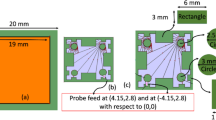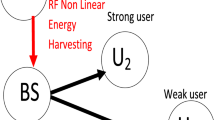Abstract
An improved MIMO radio channel simulator is proposed, based on the most popular correlation-based MIMO channel model called Kronecker model and the sum-of-sinusoids (SoS) method which is widely used to generate Rayleigh fading waveforms with temporal correlation. Firstly, a simplified simulation model for generating multiple independent Rayleigh fading waveforms is presented, which employs only one random variable to set all Doppler frequency components in all waveforms. Next, a fast spatial correlation calculation technique, in a closed-form expression implemented by the Fourier Transform both for outdoor and indoor multiple cluster scattering environments, is introduced, which accurately reproduces the desired spatial correlation properties and indicates a direct dependence between spatial correlation and channel physical parameters. The ergodic and outage capacity of the simulated channel are also evaluated with respect to different azimuth of arrival and azimuth of departure (AoA/AoD) under the condition of 3GPP SCM (3rd Generation Partnership Project Spatial channel model) [23]. The presented simulator is therefore suitable for the theoretical analysis of MIMO radio systems, including dynamic system simulation.
Similar content being viewed by others
References
Kunnari E., Iinatti J. (2007) Stochastic modelling of Rice fading channels with temporal, spatial and spectral correlation. IET Communications 1(2): 215–224
Jakes W.C. (1994) Microwave mobile communications. IEEE Press, Piscataway, NJ
Pätzold M., Hogstad B.O., Kim D. (2007) A new design concept for High-Performance Fading Channel Simulators using Set Partitioning. Wireless Personal Communications 40(2): 267–279
Pop M.F., Beaulieu N.C. (2001) Limitations of sum-of-sinusoids fading channel simulators. IEEE Transactions on Communications 49: 699–708
Zheng Y.R., Xiao C. (2002) Improved models for generation of multiple uncorrelated Rayleigh fading waveforms. IEEE Communications Letters 6: 256–258
Li Y., Huang X. (2002) The simulation of independent Rayleigh Faders. IEEE Transactions on Communications 50(9): 1503–1514
Alimohammad A., Cockburn B.F. (2008) Modeling and hardware implementation aspects of fading channel simulators. IEEE Transactions on Vehicular Technology 57(4): 2055–2069
Young D.J., Beaulieu N.C. (2000) The generation of correlated Rayleigh random variates by inverse discrete Fourier transform. IEEE Transactions on Communications 48(7): 1114–1127
Baddour K.E., Beaulieu N.C. (2005) Autoregressive modelling for fading channel simulation. IEEE Transactions on Wireless Communications 4(4): 1650–1662
Komninakis, C. (2003). A fast and accurate Rayleigh fading simulator. In IEEE GLOBECOM 03, Vol. 6, pp. 3306–3310, December 2003.
Luo, Z., & Zhang, W. (2007). The simulation models for Rayleigh fading channels. In IEEE CHINACOM 07, pp. 1158–1163, August 2007.
Foschini G.J., Gans M.J. (1998) On limits of wireless communication in a fading environment when using multiple antennas. Wireless Personal Communications 6(3): 311–335
Telatar E. (1999) Capacity of multi-antenna Gaussian channels. European Transactions on Telecommunications 10(6): 585–596
Almers, P., et al. (2007). Survey of channel and radio propagation models for. wireless MIMO systems. EURASIP Journal on Wireless Communications Network. doi:10.1155/2007/19070
Kermoal J.P. et al (2002) A stochastic MIMO radio channel model with experimental validation. IEEE Journal of Selected Areas in Communications 20(6): 1211–1226
Ozcelik H. et al (2003) Deficiencies of ‘Kronecker’ MIMO radio channel model. Electronics Letters 39(16): 1209–1210
3GPP, Physical channels and modulation, TS 36.211 V8.3.0, May 2008.
Czink N. et al (2007) Cluster characteristics in a MIMO Indoor Propagation Environment. IEEE Transactions on Wireless Communications 6(4): 1465–1475
Schumacher L., Pedersen K.I., Mogensen P.E. (2002) From antenna spacings to theoretical capacities—Guidelines for simulating MIMO systems. IEEE Personal, Indoor and Mobile Radio Communications 2: 587–592
Schumacher L., Raghothaman B. (2005) Closed-form expressions for the correlation coefficient of directive antennas impinged by a multimodal truncated Laplacian PAS. IEEE Transactions on Wireless Communications 4(4): 351–1359
Trump T., Ottersten B. (1996) Estimation of nominal direction of arrival and angular spread using an array of sensors. Signal Processing 50(1–2): 57–69
Forenza A., Love D.J., Heath R.W. (2007) Simplified spatial correlation models for clustered MIMO channels with different array configurations. IEEE Transactions on Vehicular Technology 56(4): 1924–1934
3GPP, Spatial channel model for Multiple Input Multiple Output. (2003). TR 25.996 V6.1.0.
Author information
Authors and Affiliations
Corresponding author
Rights and permissions
About this article
Cite this article
Luo, Z., Zhang, W. & Xu, Y. An Improved Simulator for the Correlation-Based MIMO Channel in Multiple Cluster Scattering Environments. Wireless Pers Commun 52, 777–788 (2010). https://doi.org/10.1007/s11277-009-9661-z
Received:
Accepted:
Published:
Issue Date:
DOI: https://doi.org/10.1007/s11277-009-9661-z




